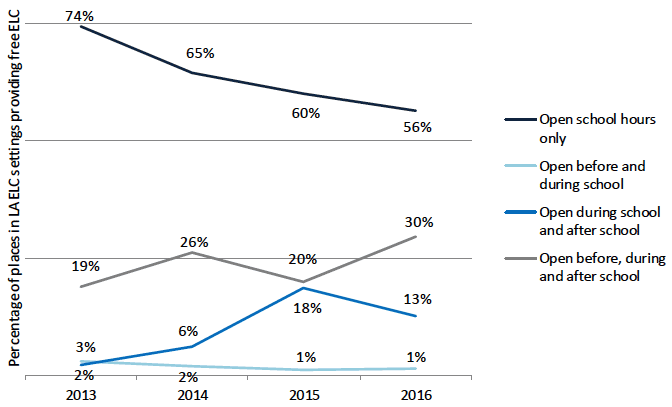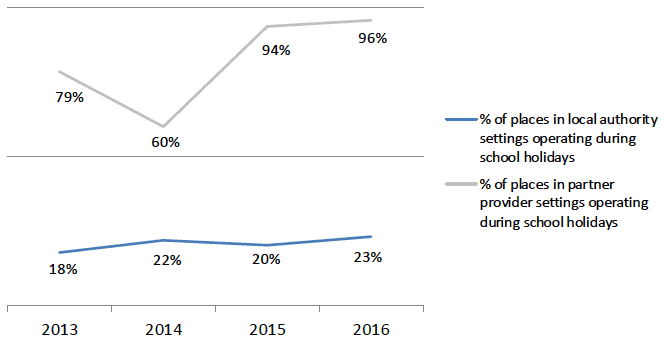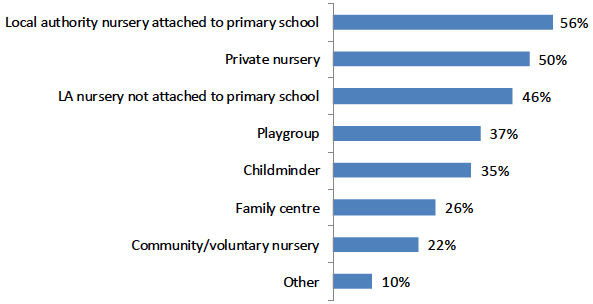The expansion of early learning and childcare: evaluation report 2017
A report exploring the impact of the expansion of government-funded early learning and childcare after 2014.
This document is part of a collection
3. Flexibility
Key findings
- Since the 2014 Act, which required local authorities to deliver more flexibility for parents, there has indeed been a trend of increased flexibility of opening hours during the day. The percentage of places in local authority settings providing funded ELC which operate before, during and after school hours increased from 19% in 2013 to 30% in 2016.
- Nonetheless, in 2016, more than half (56%) of places in local authority settings across the country were in a setting operating during school hours only.
- The percentage of funded places in local authority settings which operate during school holidays increased from 18% in 2013 to 23% in 2016.
- Private partner providers offer more flexibility for funded ELC than local authority providers. This is true for both operating hours during the day (in 2016, 66% of places in private partner providers were in a setting operating before, during and after school hours) and even more so for holiday provision (96% of places in partner providers were in a setting operating during school holidays, an increase of over 16 percentage points from 79% in 2013).
- There is significant variation across different local authorities in the extent to which flexibility in operating hours and holiday provision is offered. Many, though not all, local authorities which offer limited flexibility are more rural or remote authorities. Whilst in most local authorities the percentage of places in settings providing funded ELC which operate before, during and after school hours increased between 2013 and 2016, in seven local authorities there was a decrease.
- In the recent ELC parent survey, most parents (71%) said they would prefer to use the future 1140 hours annual entitlement every or almost every week of the year as opposed to during school term -time only.
- Most parents (65%) also prefer to use the 1140 hours in longer sessions on fewer days per week as opposed to shorter sessions spread over more days per week.
- In addition, there is considerable variation in the exact pattern in which parents would like to spread the 1140 hours, and parents indicate that their preferences may change over time due to e.g. changing work requirements or older siblings starting school. This suggests that fully flexible provision would also include the option for parents to easily change their patterns of use.
The aim of the ELC expansion is that parents will receive not only more hours of funded ELC, but also more flexibility in terms of when and where to use these hours. The intention is that increased flexibility would support more parents to work, train or study. When government-funded ELC was introduced in Scotland in 2002 (then called 'pre-school education') this was normally delivered in blocks of 2.5 hours per day over 33 weeks. After the expansion of ELC to 600 hours per year in 2014, this was initially generally delivered via five 3 hour 10 minute sessions per week over 38 weeks, but the 2014 Act placed a statutory duty on local authorities to deliver more choice and flexibility of hours of provision, based on local consultation with parents every two years. The Scottish Government also provided additional funding to local authorities to support the increase in flexibility required as part of the Act.
This chapter provides evidence on changes in flexibility of ELC provision between 2013 and 2016, and parents' needs and preferences for times and types of ELC provision. As such, it aims to explore to what extent the commitment for flexibility in the 2014 Act has been delivered; provide a baseline for monitoring and evaluating the flexibility of ELC provision as the expansion to 1140 hours is rolled out in future years; and inform the implementation of the ELC expansion to 1140 hours.
Flexibility since the expansion in 2014
Flexibility in opening hours
A comparison of the opening hours of local authority ELC settings since the 2013-14 academic year shows that there has been an overall trend of increased flexibility in opening hours since the 2014 Act. Figure 7 below shows that the number of places [21] in local authority settings providing funded ELC which only operate during school hours has fallen from 74% in 2013 to 56% in 2016. [22] Conversely, in local authority settings offering ELC before, [23] during and after school hours, the number of places has increased from 19% in 2013 to 30% in 2016. [24]
Figure 7: percentage of ELC places in local authority settings providing funded places with flexible opening hours

The private sector provides significantly more flexible options for funded ELC than local authority ELC settings. In 2016, 66% of places in a private setting providing funded ELC were in a setting operating before, during and after school hours, compared to 30% for local authority settings providing funded ELC.
Yet in contrast with the increase in flexibility in local authority providers, for private partner providers the percentage of ELC places that were in settings operating before, during and after school time remained relatively stable between 2013 and 2016, decreasing from 69% in 2013 to 66% in 2016.
Holiday provision
Between 2013 and 2016 flexibility of local authority ELC settings has also increased in terms of provision during school holidays, although the increase was smaller. In 2016, 23% of ELC places in local authority settings were in settings operating during school holidays, an increase of 5 percentage points from 18% in 2013.
In the private sector holiday provision is much more common and also saw a larger increase. In 2016, the proportion of ELC places in private partner provider settings offering funded places that operate during school holidays was 96%, an increase of over 16 percentage points from 79% in 2013. This is illustrated in figure 8 below.
Figure 8: Percentage of places in settings providing the funded ELC entitlement which operate during school holidays

Differences between local authorities
So far, the flexibility of ELC and changes since 2013 described in this report have focused on Scotland as a whole. Yet there are significant differences between local authorities, as can be seen in figure 9 below. For example, while in one local authority 95% of ELC places in local authority settings were in settings open before, during and after school hours in 2016, in some other local authorities this was 0%. Many of the local authorities with no or very few ELC places in settings with extended opening hours are more rural and/or remote authorities - though not all of them.
Figure 9: Percentage of places in local authority ELC settings providing services before, during and after school hours

Figure 9 above also shows some differences in changes in flexibility between 2013 and 2016. Whilst in most local authority settings the percentage of places offering provision before, during and after school hours increased, in seven local authorities there was a decrease.
There are also differences between local authorities in holiday provision, as can be seen in figure 10 below. For example, while in some local authorities no ELC places in local authority settings in 2016 were in settings offering holiday provision, in other authorities more than half of funded places were.
Figure 10: Percentage of ELC places in local authority settings operating during school holidays (2016)

The 2017 ELC parent survey asked eligible parents who don't use any of their ELC entitlement about the reasons for this. 14% of parents of an eligible 3 or 4 year old said a lack of choice in available opening times (19% for 2 year olds), and 13% a lack of choice in available childcare settings or types of childcare (16% for 2 year olds). [25]
Flexibility preferences for the 1140 hours funded ELC provision
Flexibility in opening times and holiday provision
The 2017 ELC parent survey asked parents with 0-5 year old children how they would prefer to spread the future 1140 hours over the year if it were available now.
Most parents (71%) would prefer every or almost every week of the year for around 22-30 hours per week
25% of parents prefer in school term time only (around 30 hours per week).
5% do not know, have no preference, or another preference
The percentage preferring ELC in school term-time only was somewhat higher amongst parents with children with Additional Support Needs (34%), a household income below £16,000 (36%), households with no parent in employment (44%), [26] and with other school-aged children (39%). There were no notable differences between parents living in urban or rural areas, or amongst parents with English as an additional language.
When asked how parents would prefer to spread the 1140 hours over the week:
most parents (65%) said they would prefer longer sessions on fewer days per week
21% of parents prefer shorter sessions on more days per week
13% do not know or have no preference
A preference for longer sessions spread over fewer days per week is seen amongst all groups of parents. But the percentage preferring shorter sessions spread over more days per weeks is slightly higher amongst parents with children with additional support needs ( 27%) and parents who also have school-age children ( 26%). It is somewhat lower amongst parents with a household income of £60,000 or over ( 15%) compared to lower income households.
In addition to the above preferences, 6% of parents with 0-5 year old children said they'd like the flexibility to include weekend provision, and 15% they'd like provision outside of normal working hours (e.g. before 8am and after 6pm). This was similar across all parent groups.
Flexibility in type of provider
The 2017 ELC parent survey also asked what type(s) of provider parents would prefer for the 1140 hours of ELC entitlement. For 3 and 4 year old children, the most commonly mentioned preferences are:
Figure 11: percentage of parents who would prefer certain provider type(s) for the 1140 ELC entitlement for a 3 or 4 year old child (2017 ELC parent survey)

Around half of parents selected two or more types of providers here, which suggests that a proportion of parents may prefer to use more than one type of provider for the 1140 entitlement, as was also mentioned in some open-text survey responses (see further below).
When parents' preferences were asked specifically for 2 year old children, amongst parents in the lowest household income group (those most likely to be eligible for funded ELC for 2 year olds) nurseries were still the most frequently mentioned type. Yet the differences are smaller with relatively more parents mentioning playgroups, childminders and family centres:
Figure 12: percentage of parents who would prefer certain provider type(s) for the 1140 ELC entitlement for a 2 year old child (2017 ELC Parent Survey)

Exploring parents' flexibility preferences
When the 2017 ELC parent survey asked parents about their preferences for spreading the 1140 funded ELC hours, it also offered them the opportunity to make additional comments on their preferences and thoughts on flexibility.
Flexibility over the year
A small number of parents provided comments on how they would use the expanded entitlement across the year. This included reference to the potential for parents' requirements to change over time (e.g. due to changing work requirements, older siblings starting school). Parents said, for example:
"School term time at the moment but if I went back to work all year round."
"It would be inconvenient to have my youngest child in throughout the full year when my eldest is in only during term time but I would certainly welcome the help during the 6/7 week summer holiday."
Flexibility over the week
A substantial number of parents provided comments on how they would prefer to spread the expanded entitlement over the week, which included a range of specific requirements in terms of the number and pattern of days per week and specific times per day. Some comments also emphasised the importance of longer sessions to enable parents to work, including early mornings and evenings, while others emphasised the need to accommodate parents' changing shift patterns.
"We work shifts so would never be able to be flexible enough at a school nursery but if private nursery would accept government funding then it wouldn't matter when they gave us the hours or how they spread it out as we would use full time and have to top up."
"We would not be able to take our child to and from a specific school nursery if they were in less than a normal working day for full time employees (8h)."
"I would prefer school hours as easier with other child in school hours to have the same drop off and pick up times."
"As well as more hours of funded places there needs to be more flexibility in how and when you can use them. My husband and I work in flexible 9-5pm Mon-Fri jobs but still find it very complicated to get childcare and use three different nurseries for just two children."
Some parents emphasised the need for flexibility on how to use their entitlement across multiple ELC providers, including local authority and private nurseries, and childminders. For example, one parent said:
"It's very restricted on how it is used and available. I have chosen a childminder and non council playgroup for my daughter because that's where she is comfortable and happy, despite me having to pay for both."
Contact
There is a problem
Thanks for your feedback